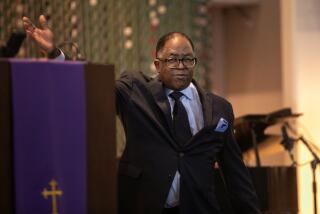Conviction Set Aside for ‘Thin Blue Line’ Character
HOUSTON — It was 12 years ago that the jury reached its verdict about Randall Dale Adams: guilty as charged in the murder of Dallas policeman Robert Wood. On Wednesday, Adams was given another chance to prove he didn’t pull the trigger, and he owes it to a movie.
A Texas appeals court in Austin Wednesday ruled that Adams’ murder conviction be set aside, based largely on new facts brought forward in the critically acclaimed documentary, “The Thin Blue Line.”
The strange and perhaps tragic case of Randall Dale Adams, 40, is one that came to the attention of New York film maker Errol Morris by accident, grew to be an all-consuming project and finally, with the release of the film last August, became a cause celebre.
As of late last year, more than 15,000 people had signed petitions pleading for Adams’ release. On some days, it seemed there had been progress, while on others it seemed that the cause was lost. Then, finally, came the ruling from the Texas Court of Criminal Appeals, which said that the prosecution suppressed evidence and knowingly allowed perjured testimony during Adams’ 1977 trial.
Adams is being transferred back to the Dallas County Jail from a Texas prison while the district attorney’s office decides whether there is enough evidence to retry the case. Adams’ lawyer, Randy Schaffer, said Wednesday that his now-famous client is trying to remain calm in the face of good news.
“Well, after 12 years, there isn’t a lot of emotion either way,” said Schaffer about Adams’ reaction to the court decision. “Until the case is over, said and done, it is still a pending case. Until this is behind him, he’s still a prisoner.”
In an interview with the Associated Press Wednesday, Adams said: “I have firmly believed someday, someway, somehow, I would prove my case. I didn’t know how, when or why. I knew.”
Recants Testimony
If Adams does go on trial again, the basic question will be what happened on the night of Nov. 28, 1976, when patrolman Wood was killed with five shots from a .22-caliber pistol. What would be different at a new trial is that David Harris, who was with Adams that night and was the prosecution’s star witness, had recanted his testimony when filmed by Morris. The movie strongly suggests that Harris, who is now on Texas’ Death Row for another slaying, killed Wood.
Errol Morris had never heard of Randall Dale Adams when he came to Texas to make a movie in 1985. He was interested, instead, in a man named James Grigson, a Texas psychiatrist nicknamed “Dr. Death” because his testimony had helped send Adams and 26 others to Death Row.
In the course of his research, he came across Adams and his story. At first, Morris didn’t believe him. But as more and more facts checked out, he began to be swayed, and finally convinced. Thus began a three-year project that would become “The Thin Blue Line.”
The opening segment of the story is clear and undisputed. Adams, a high school graduate from Ohio with no criminal record, had traveled to Dallas because he had heard there was work to be found. About two weeks after his arrival, his car ran out of gas and a young man driving a 1972 Mercury Comet offered to give him a lift.
The driver of the car, which had been stolen the day before, was a 16-year-old named David Harris with an extensive criminal record. He had grown up in Vidor, Tex., which over the years had developed a reputation as one of the toughest towns in the state.
The two spent the day together. They drank beer, smoked marijuana and pawned some tools. That evening, they went to a drive-in theater where a soft-core porn double feature was playing. It is here that the two stories diverged. Adams claimed that he tired of “The Swinging Cheerleaders” and his young companion halfway through the feature and that the two parted company before 10 p.m. In Adams’ story, he was asleep in his own apartment when Wood was killed.
Harris said at the time that it was after midnight when the two left the drive-in. He claimed that Adams was driving when a patrol car stopped them because their lights were out.
When Wood approached, he was gunned down by the driver of the car. Wood’s partner, Teresa Turko, opened fire as the car sped off. She would later testify that the driver of the car had bushy hair like Adams’. But what jurors were not told was that the only description Turko could give in her original report was that the driver was wearing a coat with a turned-up fur collar.
That, however, was only one of several things the jury, as well as the defense lawyers, were not told. They did not know that one surprise eyewitness who named Adams as the killer had originally been unable to pick him out of a lineup.
Harris was arrested in connection with the case in Vidor a month after the killing. All charges against him were dropped after Adams was convicted.
Adams was sentenced to death, but the U.S. Supreme Court ordered a stay one week before he was to be executed. Ultimately, Gov. Bill Clements commuted the sentence to life in prison. Subsequent requests for a new trial were denied.
Morris came on the scene and began to form the theory that it had been Harris, not Adams, who had committed murder.
“At the point I met Harris, I had serious suspicions about the entire case,” said Morris in an interview Wednesday. “Harris had indicated he would never forget the look in the cop’s eyes, which is a peculiar thing to say considering he claimed he was slumped down in the back of a car.”
Causes Major Stir
When the movie came out, it caused a major stir in Dallas, which the distributors said was intended. In the movie and later interviews, Harris virtually confessed to the murder.
“We designed our distribution plan so that it could make a difference,” said Harvey Weinstein, co-chairman of Miramax Films. “We wanted to bring this movie to the attention of the people that mattered. We set the goal to accomplish a retrial and later an exoneration of Randall.
“Every time there was a newsworthy event, the film would reemerge and keep the issue alive,” he said. “We were aware that by keeping the film going, we could put pressure on and activate people to step out.”
Last Nov. 30, based on evidence presented in the movie, a hearing was held in Dallas to determine if a new trial should be recommended. Schaffer, Adams’ lawyer, asked Harris point blank if Adams had killed the policeman.
“No, he did not,” Harris said. “Randall Adams knew nothing about this offense and was not in the car at the time.”
With that, Judge Larry Baraka said that in his court, Adams would have been found innocent and sent the case to the appellate level for a final ruling.
Last Friday, those working for Adams’ release suffered a major setback when he was refused parole despite Baraka’s strong backing. And that refusal made the decision Wednesday all the sweeter.
“My response is one of great joy. The nightmare is over,” said the film’s producer, Mark Lipson. “I started to feel a sort of sick feeling when he was denied parole that we would enter a downward spiral and our energy would not be able to last. I was nervous that the storm had blown over in Texas and things would go back to the status quo.”
In Columbus, Ohio, Adams’ mother, Mildred, was basking in the news. Her home had been wall-to-wall people all day.
“I just prayed and prayed last night that God would work this out,” she said. “And I told God, ‘I know you’re bigger than the state of Texas, and I just don’t know what to do anymore.’
“So there is justice in Texas after all.”
More to Read
Sign up for Essential California
The most important California stories and recommendations in your inbox every morning.
You may occasionally receive promotional content from the Los Angeles Times.










